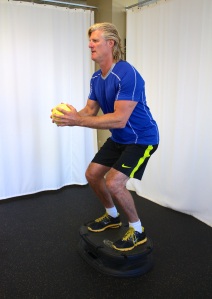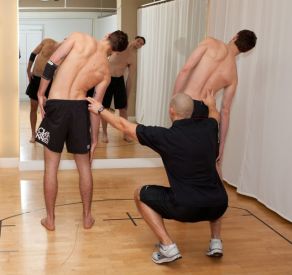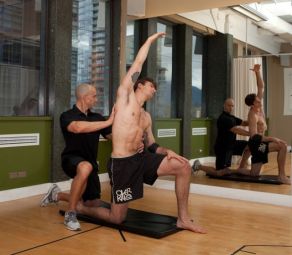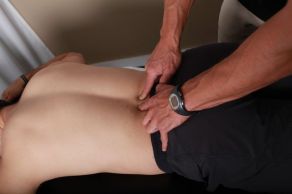I spent time this week working with two separate clients to help them manage their neck pain and stiffness. Both of these individuals get headache symptoms when their neck gets bad, so they’re very motivated to make improvement.
Sitting atop the rest of the body, your head and neck are subjected to a lot of different loads and forces, depending on how you move and carry yourself. Think about it. Through your vision and balance mechanisms, your head is always trying to right itself and stay level. If your pelvis is unlevel, you have stooped, forward posture, or your overall movement is off-balance and erratic, your head and neck are going to have to compensate.
Additionally, because of our jobs and technology like computers and smart phones, most of us spend time in a position of forward head carriage, which overloads the muscles of the neck and upper back. Any time the head or neck is out of neutral alignment, some muscles are getting an opportunity to shorten and tighten, while others become overstretched, creating muscle imbalance.
It’s usually not very effective to address problems at the extremities without discussing the body’s central stability and power centers of the core and pelvis. I’m going to assume you’ve been reading my earlier columns, and have taken a good look at your overall posture and alignment, while working to develop good neutral spine and pelvic positioning and core function.
When exercising, always remember to perform a progressive warm-up beforehand, and be sure to get medical approval before starting a new fitness program. Because the neck can be particularly sensitive or unstable, I always recommend very slow and careful progression of any movements. Be sure to stop if you feel anything negative, like pain, dizziness or numbness or tingling in your limbs.
 Knowledge – More than any other area of the body, it’s important to know exactly what is going on with your neck. Because of the high degree of mobility of the joints in your cervical spine, and the complicated spider-web of muscles and other connective tissue in the area, there is a lot that can happen in this region, and a lot that can go wrong. Without any prior knowledge, I’ve had clients who’ve had X-rays of their spine reveal significant misalignment of the bones in the neck, with advanced degenerative changes, including bone spurs, reduced joint spaces and so on.
Knowledge – More than any other area of the body, it’s important to know exactly what is going on with your neck. Because of the high degree of mobility of the joints in your cervical spine, and the complicated spider-web of muscles and other connective tissue in the area, there is a lot that can happen in this region, and a lot that can go wrong. Without any prior knowledge, I’ve had clients who’ve had X-rays of their spine reveal significant misalignment of the bones in the neck, with advanced degenerative changes, including bone spurs, reduced joint spaces and so on.
In instances like this, I’ve heard the rationale of ‘if it isn’t broken, don’t fix it’, meaning that if the person with the degenerative neck isn’t experiencing pain or discomfort, why change anything. My rationale is always the same. It’s only a matter of time before the stress that has caused the physical changes to the neck results in some kind of serious, acute incident. Why not get a thorough assessment by someone you trust, and begin to change your lifestyle and exercise habits to improve your neck, rather than letting it get worse? This includes focusing on your posture and head position as much as possible.
 Treatment – I fully appreciate how fragile you can feel when your neck gets very bad and you’re experiencing sharp pain and headaches. If you’ve already had a thorough diagnosis and are aware of problems with the bones, joints or disks in your cervical spine, it can be very daunting to try to exercise your neck. However, just like any other part of the body, if you don’t use it, your neck will get less and less healthy.
Treatment – I fully appreciate how fragile you can feel when your neck gets very bad and you’re experiencing sharp pain and headaches. If you’ve already had a thorough diagnosis and are aware of problems with the bones, joints or disks in your cervical spine, it can be very daunting to try to exercise your neck. However, just like any other part of the body, if you don’t use it, your neck will get less and less healthy.
For acute neck issues you may need to ice the injured area, or possibly taking anti-inflammatory medications. I also recommend the help of a good physiotherapist or chiropractor to manage the acute injury. Very gentle flexibility and range of motion activities, can really help to loosen a painful neck. For chronic tension in the muscles, try applying heat, or rolling the muscles on a roller or small ball.
 Prevention – One of the best ways to avoid neck problems is to pay close attention to your overall body alignment during your daily activities. For example, I use an excellent ergonomic chair and keyboard when I sit to write my columns, and take frequent micro-breaks to move my body and reset my alignment. When you’re exercising, always use good body position and core function strategies to improve your movement efficiency.
Prevention – One of the best ways to avoid neck problems is to pay close attention to your overall body alignment during your daily activities. For example, I use an excellent ergonomic chair and keyboard when I sit to write my columns, and take frequent micro-breaks to move my body and reset my alignment. When you’re exercising, always use good body position and core function strategies to improve your movement efficiency.
Another key point is to remember to focus on balanced flexibility and strength in your neck. Regularly performing light range of motion movements and stretches should help your mobility, and it’s very easy to perform gentle strengthening exercises in a variety of directions using only the pressure of your hand. Of course you want to be sure that your cervical alignment is healthy and stable before doing any resisted work with your neck, so as to avoid any risk of injury or complications.
–Rob Williams is a kinesiologist, elite personal trainer and posture specialist. He has been practicing for 16 years and currently operates an exclusive private training studio Mixx Fitness Studio, with a team of 10 trainers, as well as a multi-disciplinary posture facility, Performance Posture Clinic. Rob is an accomplished writer and speaker in the fields of fitness, posture and nutrition, and can be contacted at Williams Health Group.















